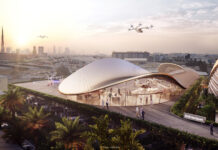By Elizabeth Broomhall www.arabianbusiness.com
Located on the north-easterly coast of the Arabian Peninsula, the State of Qatar, traditionally somewhat understated and known only for its gas reserves, is today one of the most significant countries in the Middle East. Characterised by a cash-rich and ambitious government, over the years it has become a highly attractive market for construction firms seeking new business, not least because of its ability to offer contract opportunities at a time when much of the rest of the world, was foundering.
 But in sharp contrast with some other emerging markets, what makes Qatar particularly interesting is the fact that it is currently one of the richest countries in the world, with a $128 billion GDP in 2010 and one of the world’s highest GDP growth rates. It is no doubt, thanks to this strong economy, that Qatari officials are confident in the state’s ability to host the FIFA World Cup in 2022.
But in sharp contrast with some other emerging markets, what makes Qatar particularly interesting is the fact that it is currently one of the richest countries in the world, with a $128 billion GDP in 2010 and one of the world’s highest GDP growth rates. It is no doubt, thanks to this strong economy, that Qatari officials are confident in the state’s ability to host the FIFA World Cup in 2022.
“Qatar is a very promising market,” says Arabtec’s Qatar resident director Ayman Al Barqawi, who is involved in the firm’s big projects and tenders in the state. “It is attractive to contractors because the market is very strong. If it wins the World Cup bid that will be a big boost for the country, as well as for consultants and contractors.”
Certainly, UAE-headquartered developers working in the region have a similar view. Particularly confident is Marwan Shehadeh, group director of Al Futtaim Capital – developer of Qatar’s biggest ever shopping mall. “Qatar has huge growth potential for the future, with a solid government behind the economy,” he says. “It is actually very comforting to know that the government is there to support the right projects.”
Unsurprisingly, Qatar-based developers such as Barwa Real Estate are also rather optimistic. “The Qatar economy has stood up throughout the financial crisis,” a spokesperson from the company explains. “One thing you notice, particularly when you come from places like Dubai, is that the cranes are still working. This is because the heartbeat of the economy has continued to pump throughout the recession.”
Opportunities
When it comes to construction opportunities in Qatar, the majority of available contracts are in the infrastructure market. As well as an array of ongoing and planned road, bridge and utilities projects by Ashghal, the country is also investing in the development of the New Doha International Airport (NDIA); a new, deep-water Doha Port, set to replace the existing port; on top of a sophisticated metro system forming one part of country-wide, integrated, railway network.
In addition, only last week, the Qatari finance minister confirmed that as much as 40% of the budget between now and 2016 would be allocated to infrastructure projects, with approximately $140 billion to be spent on the sector over the next ten years.
“Infrastructure is definitely the area where there are the most opportunities,” says Al Barqawi. “Even if Qatar doesn’t win the World Cup 2022 bid, I believe there is still going to be a lot of expansion in this area, partly because there is huge demand for infrastructure, and partly because the government has a lot of ambitions.”
Atkins’ country director for Qatar, Gordon Jack, agrees. “Undoubtedly the biggest market for contractors in Qatar is infrastructure,” he says.
And yet, infrastructure is not the only area of opportunity. According to property analysts Colliers International, there is also a large amount of scope in the residential and retail sectors.
“One area of demand is the housing sector,” says JP Grobbelaar, director of development for the firm’s consultancy arm. “Current demand is 142,000 units, but existing supply is only around 102,000, which means the market is under supplied by as much as 40,000 units.”
With this however, he explains that demand is really only at the low end and in the middle of the market, the more expensive, sub-sector having been oversupplied by luxury developments previously.
“If you look at the sub-sectors, the high end of the market is actually becoming saturated. Developers have been focusing on this end because this is where the larger profits lie.” He adds: “The truth is that the greatest demand for residential space comes from the expatriate population, which is far bigger than the local population. So as the expatriate population is growing, so is demand for mid-high end properties, things like townhouses, villas and apartments. That is an area of the market which could quite lucratively be looked at by developers inside and outside of Doha.”
Grobbelaar is less optimistic about the hospitality and office markets, which are heading towards total saturation.
As for retail however, there seems to be even more room for growth. Thus, with just 630,000m2 of gross leasable area (GLA) presently, and the potential for up to 1,000,000m2 of space in total, Doha continues to be under supplied in this sector, even after an increase of 31% GLA in 2009. This, combined with high disposable incomes among individuals, would point to huge opportunities in this sector.
“Doha has one of the highest GDPs in the world, so it is a wealthy country, and individuals have a high disposable income. Unfortunately, the Doha retail market is undersupplied both in terms of quantity and quality. Compared with Dubai, Doha’s shopping centres wouldn’t crack a nut.”
Al Futtaim’s Shehadeh has a similar view, hence the development of its 2.5 km mall, which is due for completion in 2015 and likely to be named Doha Festival City. “We believe there is a gap in the Doha market today, and a strong demand for proper, super-regional, retail and entertainment destinations. Qatar is probably the richest city in the world and yet they don’t have world-class retail destinations.”
Nevertheless, how many opportunities will become available is not known. “I don’t know if Qatar will allow many more malls, as I know Doha wants to be careful not to overcrowd the market,” says Shehadeh.
On the contrary, Grobbelaar believes there are opportunities, but that firms should be careful. “Anybody who comes to Doha and builds a cracking shopping mall will do well. That said, there is quite a lot of development happening in Doha, so companies should enter the market with caution.”
Getting it right
For all of Qatar’s positives, of course, there are always going to be drawbacks. According to those working in Qatar, many of these are fairly typical of new markets, while others are more specific to the region. High competition for both contractors and developers, probably falls into the latter category. “Qatar is very competitive, internationally and locally, with many people interested in this country,” says Al Barqawi.
“To achieve competitive advantage you need to sharpen your pencil, you need to go there, survey the market, invite bids from different contractors and suppliers, and you need to negotiate with developers at the stage of tender or before tender. Definitely companies need to be on the ground and registered here, rather than bidding from satellite offices.”
Jack from Atkins explains how one of the biggest problems with competition, at least for contractors, is the number of companies competing and at very low prices. “We cope with the competition by being here on the ground and by understanding the market, but it doesn’t protect us from the exceptionally low tendering that is going on at the moment,” he says. “That said, we do have clients that come back to us because we have delivered quality.”
Related to this are the challenges that arise from tough contract conditions. Contractors and consultants highlight not only that bond and penalty requirements are demanding, but that more often than not, they will be in the client’s favour.
“Things are changing, but companies need to read their contracts very closely, because if it looks onerous, believe me, it will be implemented in full,” says Jack. However, he says that with the right approach, companies will be successful.
“I think Qatar is like any other country in the Middle East. You have to understand the protocols for setting up office and winning contracts. It is also important to understand the local terms and conditions, cultures and behaviours, and as with anywhere, to really understand your client.”
The other difficulty encountered by some contractors in Qatar to date, has been a problem with payments. Whether or not this is more of an issue in Qatar than anywhere else is unknown, but across the board, companies seem to agree that the collection of receivables is not as straight forward as might be expected. Asked about individual experiences, Al Barqawi admits that Arabtec have experienced problems with one of their projects in the region, but luckily none with the other two. He says this makes the country a “reasonable” place for payments – the majority of its partners living up to their contractual obligations.
“Qatar is like other places when it comes to payments. You need to treat every project on its own merits. One of the things you should consider when you tender for a project is the portfolio of the client or the agency.”
Evidently, contractors are not the only ones to encounter difficulties. Developers too, have their own set of problems.
“One of the big worries is that if Qatar wins the World Cup it could over-heat the construction market. This is a problem for developers as we pay the bills. It doesn’t outweigh the benefits, but it is a downside.” says Shehadeh. “Other challenges include the limited availability of good contractors and a lack of real estate funding. Banks are still reluctant to lend to real estate projects.”
Ultimately however, the question for both contractors and developers is whether Qatar offers more benefits than it does risk, and the answer across the board is most certainly yes. “It was very easy to enter this market,” says Al Barqawi. “The process was very smooth and it is a very good place to do business. If you look at the policies and procedures here they are also very good, and they are easy. There isn’t a lot of bureaucracy here.” In addition, Shehadeh points out that the country is cutting edge in terms of sustainability and efficiency, and adherent with best practice more than ever before.


















